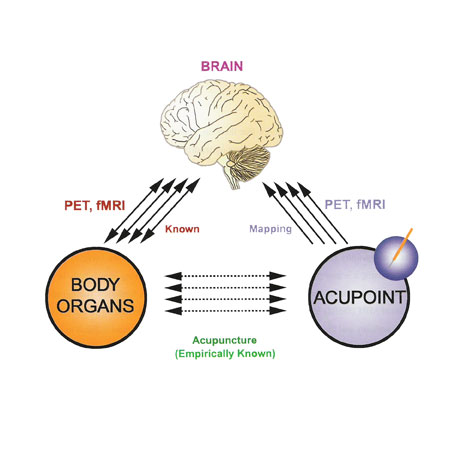The myth that acupuncture only treats pain began with the first nationally televised acupuncture treatment. Learn how acupuncture trreats the underlying cause of illness.
In the 1970's, open heart surgery using acupuncture anesthesia was broadcast nationally. Since that time, many people remember that acupuncture stops pain. Further scientific research has proven that acupuncture can stimulate endorphins and enkephalins, the body's naturally occurring opiates that control pain.
In the case of acupuncture anesthesia, an acupuncturist does stimulate the release of naturally occurring chemicals within the body so that there is little or no need for additional anesthetics. This reduces the risks associated with operations and also allows for swifter recovery periods. However, an acupuncturist uses different techniques other than acupuncture anesthesia to stop pain when treating acute or chronic pain or when treating internal medicine disorders. Additionally, endorphins and enkephalins are not the only beneficial and naturally occurring chemicals that acupuncture can stimulate.
Acupuncture can restore normal hormonal secretions to balance menstrual disorders, stimulate fibrinogen to help in the healing of wounds, stimulate enzymes to aid digestion, and acupuncture can increase the local micro-circulation of blood to speed tissue repair. So, when a patient asks me, "I feel much better, but are you just hiding the pain?”, the answer is that acupuncture not only stops pain but also reduces swelling and assists in the healing of the underlying disorder. In Traditional Chinese Medicine, acupuncture is applied to eliminate both the symptoms and the root underlying cause of the problem.
Acupuncture has an advantage over medications for the treatment of pain in the case of arthritis and chronic inflammatory diseases. Acupuncture can prevent morphological change of soft tissue and bony structures. For example, acupuncture can prevent an arthritis sufferer's fingers from twisting and bending over the years. How? By decreasing the inflammatory process, cells called osteoblasts do not build up bony structures in response to inflammation. Rather, acupuncture promotes homeostasis of the endocrine system such that osteoblast-osteoclast balance is achieved. Acupuncture achieves this balance by stimulating the micro-circulation of blood to the affected regions thereby preventing the body’s chemical factory, the endocrine system, from releasing a cascade of chemicals that cause tissue malformation. This cascade of inflammatory chemicals that cause pain, known as the ‘complement cascade’ in western allopathic medicine, is stimulated by excess sympathetic nervous system stimuli. Acupuncture can balance the nervous system signals in the local region of pain or disharmony by promoting homeostasis of the parasympathetic and sympathetic nerve stimuli in the region. This is the mechanism by which acupuncture prevents morphological decay in areas of pain and inflammation.

How does acupuncture work?
Acupuncture point stimulation directly sends bioelectric signals to internal organs and body parts to enhance the microcirculation of blood, qi (energy), and bodily fluids. In many cases, this quells excess sympathetic nerve stimulation and enhances parasympathetic nerve impulses. Ultimately, acupuncture has been empirically proven to balance the stimuli of these two branches of the autonomic nervous system to enhance the body’s natural healing powers. Studies prove that acupuncture stimulates branches of the autonomic nervous system to activate secretions from the endocrine system. In plain terms, the endocrine system is our natural pharmaceutical factory in our bodies. Acupuncture creates electrical responses that stimulate the nervous system which in turn stimulates the production of bodily chemicals needed to repair tissue and the internal organs.
MRI imaging of the brain (PET scan, fMRI) reveals that acupuncture directly stimulates the brain to encourage healing throughout the body. Acupuncture point SJ5, located on the forearm, benefits hearing. MRI studies show (as pictured above) that needling this point stimulates the auditory centers of the brain. Likewise, needling an acupuncture point on the toe which benefits vision shows stimulation of brain optic centers in MRI imaging. After numerous MRI studies, it is conclusive that acupuncture regulates brainwave activity to encourage healing within the body.

Commonly Treated Disorders with Acupuncture & Herbs
The following are conditions that I treat on a daily basis and get results:
- Pain & Numbness
- Low Back Pain & Disc Problems
- Neck & Shoulder Pain
- Carpal Tunnel Syndrome
- Headaches and Migraines
- Sciatica & Radiating Nerve Pain
- Knee Pain & Hip Pain
- Allergies, Asthma, and Sinusitis
- Repetitive Strain Disorders
- Arthritis & Tennis Elbow
- Stop Smoking Program
- Interrupted Sleep & Insomnia
- Stress, Depression & Fatigue
- Immune System Deficiency
- Whiplash
- Psoriasis, Eczema, & Acne
- Gynecological Concerns & PMS
- Menopause & Hot Flashes
- Menstrual Cramps
- Urinary Tract Disorders
- Ear Infections & Eye Disorders
- Acid Reflux & Heartburn
- TMJ and Jaw Pain
- Herpes Simplex II
- Constipation & Diarrhea
- Infertility & Morning Sickness
- Digestion Issues, Diverticulitis
- Nausea, Vertigo, and Dizziness
- Restless Leg Syndrome
- Autoimmune Disorders
- Tremors and Seizures
- Fibromyalgia
- Tennis Elbow
